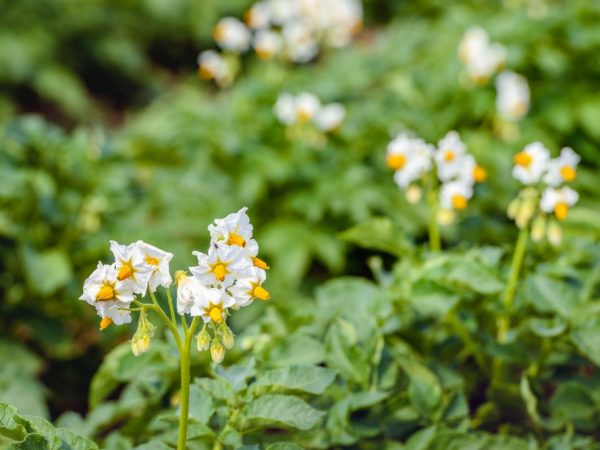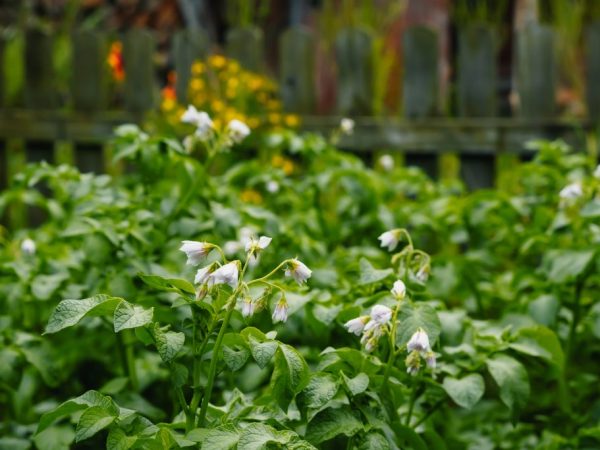Characteristics of Labadia potatoes
Labadia potatoes are a popular Dutch high-yielding table variety. The variety is quite new (it was introduced into the State Register only in 2012), but in this short time it managed to fall in love with many gardeners. We will consider the description of the variety in more detail in the article.

Characteristics of Labadia potatoes
Variety characteristic
Labadia is a medium-early ripening variety that gives a rich harvest of large fruits. The vegetative period is about 75-85 days, the lodging of tops occurs in 105-110 days. The yield of the variety is 300-450c / ha.
Labadia is geographically oriented for the Central, Central Black Earth, Ural, Volga-Vyatka, Middle Volga and North Caucasian regions.
Potatoes are resistant to high temperatures and drought, show consistently good results on various types of soil. With the pre-planting treatment of young tubers with biostimulants, it is possible to grow a crop as a two-yield crop.
Description of the plant
The culture meets this characteristic:
- tall bush, standing straight or semi-straight (relatively sloping);
- stems are powerful, well developed;
- foliage is large, slightly wavy at the edges;
- leaves are colored light green;
- the corolla is medium large;
- flowers are white;
- shoots of the same type, leveled.
Description of the fetus
One bush of the variety accounts for an average of 6 to 10 potatoes.
- fruits are large (100-150g), oval-elongated;
- eyes are small, moderately deep;
- yellow peel with a rough surface;
- the pulp is colored creamy yellow;
- the starch content is 12-16% of the total weight.
The description of the tuber does not always coincide with the declared one. This is due to differences in growing conditions.
Application
Potatoes have an excellent taste, ideal for baking (alone or as part of other dishes). During the cooking process, it boils a little, so it is recommended to reduce the cooking time slightly relative to the standard recipe, or add it to the cooking dish a couple of minutes later.
Labadia is distinguished by good transportability and keeping quality of fruits, which makes the crop the optimal commercial variety.
Care

Proper care will allow you to get a good harvest.
The variety is quite unpretentious, but in order to improve the quality of fruits and increase yields, the requirements of agricultural technology should be followed. Loosening is done to improve air and water permeability of the soil.
Loosening
The root system of potatoes needs more air than other vegetable crops. With a lack of air due to the formation of a crust on the soil or an excess of moisture, plants may stop forming fruits. Therefore, the root zone should always be loosened and slightly moistened.
The first loosening is carried out before the beginning of germination (5-7 days after planting), combined with cleaning the area from weeds.Subsequent procedures are carried out carefully so as not to harm the tops, the time of their implementation depends on the rate of hardening of the soil (crusting).
Hilling
Hilling is carried out exclusively in a humid medium warm climate. When carrying out the procedure in hot dry summer, there is a high risk of crop loss. It is necessary to huddle after watering, early in the morning or late in the evening (when the daytime heat subsides). The procedure is repeated twice until the flowering phase of the plant - with a bush height of 13-15 cm and after 3 weeks.
Watering
The volume and amount of irrigation depends on the composition of the soil and the climatic conditions of cultivation. In rainy weather, it is watered already in the flowering phase (when the crop needs an increased amount of moisture). With a moisture deficit, the tops begin to wither and lose their elasticity, the plant needs watering at the rate of 50 liters per m2 (so that the entire fertile layer is saturated with water).
In temperate climates, the culture will require three waterings per season - after germination, when the first buds appear, and after flowering. A larger amount will provoke stagnation of moisture in the soil.
Fertilizers
It is recommended to apply fertilizers even on the most fertile soil. For the first time, fertilizing is applied 30-35 days after planting, then fertilization can be synchronized with watering the crop (during the period of bud formation and after the end of flowering). You should be careful with the dosage of nitrogen baits (especially nitrate), because they can cause the accumulation of nitrates in the fruit.
For the growth and development of the variety, fertilizing with the content will be useful:
- urea (urea);
- superphosphate;
- sulfate;
- potassium chloride;
- Bordeaux liquid;
- bird droppings.
Diseases

The cultivar is resistant to infection by the golden nematode
Labadia potatoes are resistant to diseases such as:
- golden nematode (globoderosis);
- wrinkled mosaic;
- potato cancer.
The variety demonstrates an average degree of resistance in relation to:
- striped type of mosaic;
- foliage curl virus;
- late blight of fruit and tops (brown rot).
Classification
The most dangerous for the variety are such diseases of three types of origin:
- Fungal - alternaria (dry spot), phoma (gangrene, phoma rot, button disease), common scab, rhizoctonia (black scab), powdery and silvery scab, fusarium wilt (dry fruit rot), verticillary wilt.
- Bacterial - brown bacterial rot, ring rot, black leg.
- Viral - speckled mosaic, Gothic (fusiform) of fruits, necrosis (spotting) of fruits, stem nematode.
Fungal lesions are considered the most serious for potatoes. In order to preserve most of the crop, the control of the spread of fungal spores must be started as early as possible (in the early stages of spread). It should be borne in mind that some types of fungi can be in the soil in a state of suspended animation for up to 6 years. Tubers containing fungal spores should never be eaten, because some of them can also cause disease in humans.
The increase in the prevalence of bacterial lesions was caused by the introduction of mechanized harvesting of fruits and the damage caused by it to tubers. In most cases, contamination with harmful bacteria occurs during the harvesting phase, sorting the potatoes and preparing them for planting.
Infection of a culture with a virus, like a bacterial infection, cannot be cured. Viruses are transmitted from sick individuals and some species of insect vectors.
Pests
The greatest danger to Labadia is posed by the following pests:
- Colorado beetle,
- click beetle larvae (wireworms),
- potato scoop,
- potato moth,
- potato nematode,
- aphid.
In addition to the infections carried on themselves, insects harm the culture by eating leaves, stems, fruit, and the root system.The damaged plant experiences an acute deficiency of nutrients and moisture, which leads to growth arrest or even death.
In the early stages of the invasion of pests, it is recommended to carry out manual collection, with a more extensive lesion - treating the plant with folk remedies and insecticides.
Conclusion
Labadia potatoes are one of the best new varieties released for the middle lane. The culture has excellent commercial characteristics, excellent taste and keeping quality. The combination of unpretentious cultivation and a guaranteed rich harvest makes the variety attractive both in industrial cultivation conditions and in a small summer cottage.


